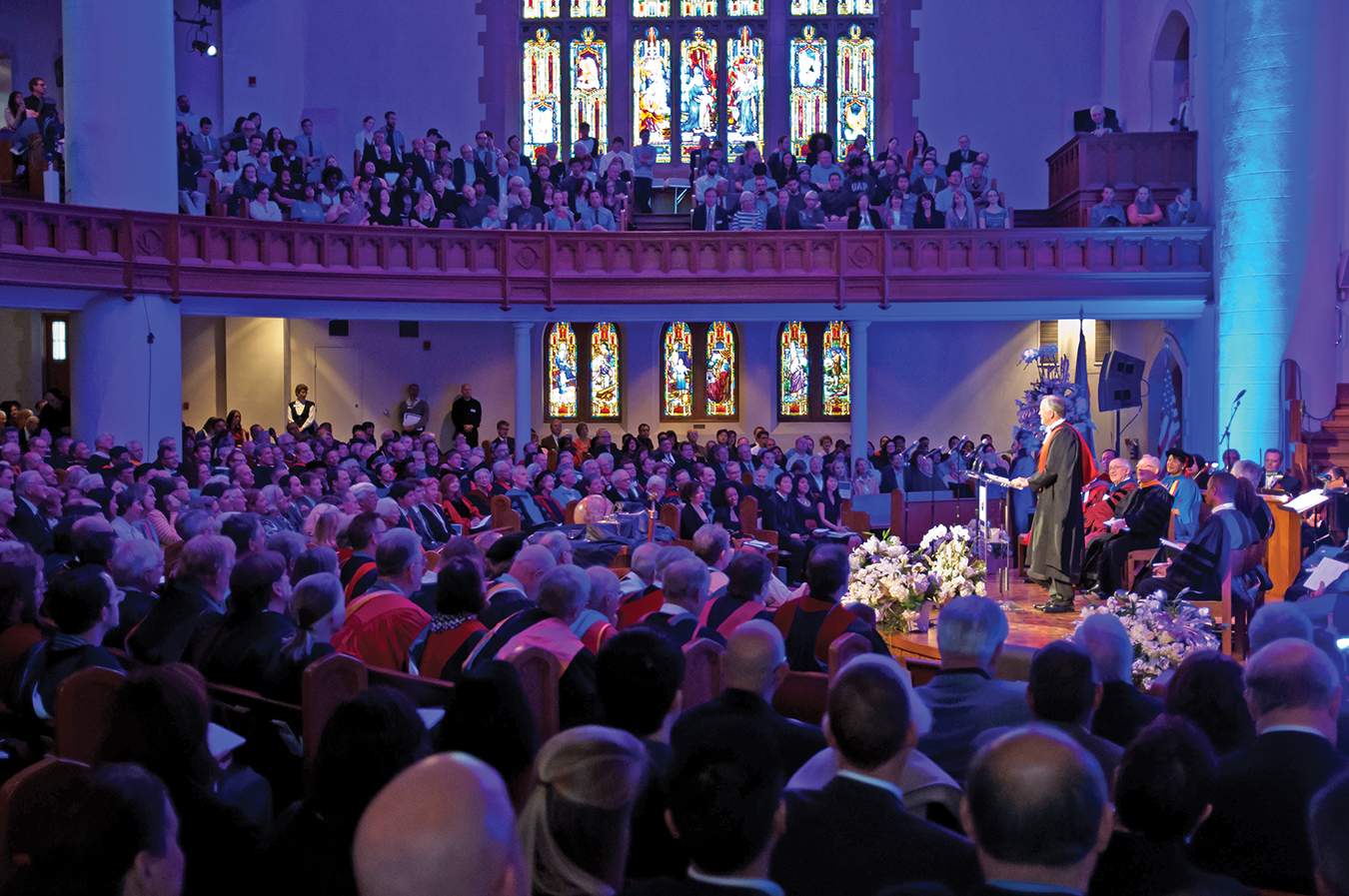
All Rick Barger really wanted was to walk up the center aisle of chapel on an ordinary Tuesday, and answer a few good questions about becoming the president of Trinity Lutheran Seminary in Columbus, Ohio. He would pledge to commit himself wholly to the task. And that would be it. Nice and simple. A new era could begin for the seminary and its newly called leader.
Barger says he found the idea of an inauguration event off-putting. “The last thing I was thinking was an inauguration service,” he says. “I mean, I’m not a king. I found the talk about the service to be a bit much. All the pomp and circumstance — in the beginning it terrorized me.”
Not surprisingly, other voices prevailed. The strong message Barger received from Trinity was: “It’s a new day. Trinity needs to celebrate this.” And so on Reformation Sunday in 2013 there may have been a little bit of pomp and a dash of circumstance, but mostly it was joyful celebration wrapped in worship and accompanying events that reflected both the seminary and its new head.
“The service itself was liturgical, but it also had a whole lot of flair to it — in terms of music I love,” says Barger. “It was very little about me, and very much about the vision and what God might be calling Trinity to be. It was about a new day, and a timely day, because we all know the challenges that the church and seminary face. It was just a very joyful time.”
Samuel Lamerson is president of Knox Theological Seminary in Fort Lauderdale, Florida. Inaugurated in November 2014, he resonates with Barger’s initial discomfort. “One of the great qualities of a seminary president is humility,” he says. But humility and inaugurations don’t exactly go hand in hand.
For Lamerson, his reluctance began to shift when he started to understand how important the inauguration would be for the seminary. “It needs to be done for the school,” he says. “It’s not really about us. We need to let it be for the Kingdom — and the school — and the Lord.”
And so from the files and experience of the recently inaugurated and those who plan, budget, and manage the events — from flowers to speakers to microphones — what follow are tips for doing presidential inaugurations well, and for all the right reasons.
The right committee sets the right tone
When Robin Steinke was named president of Luther Seminary in St. Paul, Minnesota, she knew she should not chair the inauguration committee. “From day one, I knew I needed a senior competent member of the staff to be the convenor of the committee,” says Steinke. “I was eager to meet them and share ideas, but to tap someone else to lead it was essential. A representative team would be key to making it an event for the whole school.” They would be the folks who would be best to veto even good ideas if they were not the right fit for the seminary.
Craig Koester is academic dean at Luther, and he sat on the committee. “Because we’re dealing with an event for the whole school, in the planning process we wanted to have members that represented perspectives across the constituency of our community,” he says. Koester calls the meetings “circles of conversations,” which both identified priorities and drew the community together to celebrate a transitional movement in the life of a school. The committee included administration, staff, faculty, and student representatives, as well as a board member.
Victoria Smith, director of events at Fuller Theological Seminary in Pasadena, California, affirms the need for a representative inauguration committee. “You want to engage all stakeholders right away,” she says. “Parent communities (if you have undergrad students), marketing and all that entails, faculty, donors, and current students for sure. Putting on a good, clean, smoothly running event is the bare minimum of what you want to accomplish,” Smith says. Smith advises that the right working groups and committees, created at the very beginning of the process (and at least five months before the event), can keep everything running well. “This is the institution’s chance to make a statement about who they are, what they do, why it matters, and how they are different from other institutions.”
Ask the right questions
Luther’s main committee and break-out working groups asked multiple questions throughout the process: Who is here? What shapes our mission currently? and more, says Koester. “The planning process very intentionally met many times to talk at the conceptual level early on,” he says.
President Steinke agrees. “We let the question, ‘What does the institution most need in this time of transition?’ shape the content, and not ‘What would I really enjoy?’” she says. “It was also helpful to think about what kind of event this is. Academic? Church? Donor? Inter-faith?”
Or is an inauguration all those things wrapped into one? For Luther Seminary, the consensus was that the academic community needed to feel a sense of hope and promise for the future. At first, Steinke thought that would mean a long, traditional inaugural address from her, but in the end, they decided against the inaugural speech. Instead, the committee crafted a service that included short addresses from a faculty member, an alumnus, and a dear friend of Steinke herself. “Then I took about seven minutes to do a kind of close. It was a tapestry,” she says. “I wanted to reflect how we were going to move into the future.” Together.
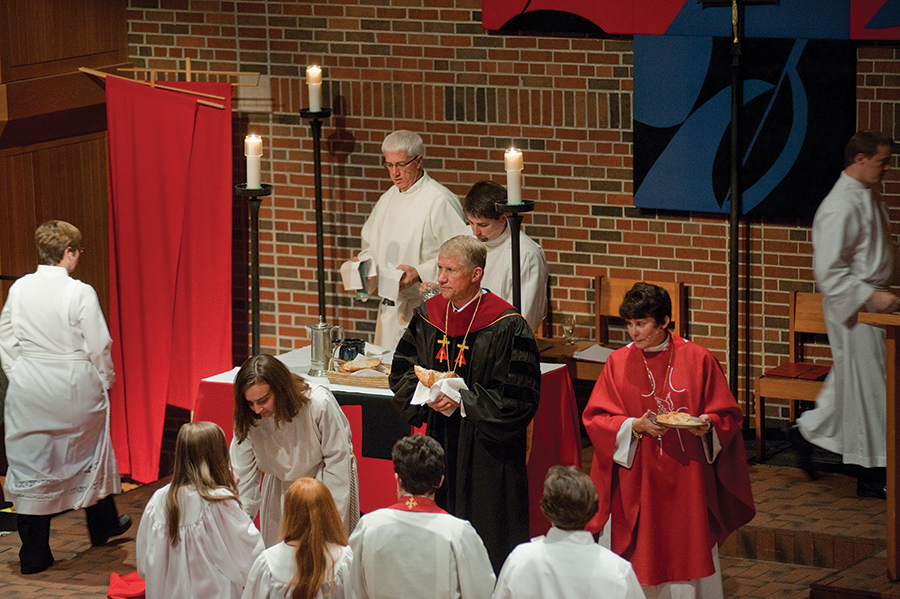 |
Rick Barger's inauguration as president of Trinity Lutheran Seminary was held in October 2013 in the seminary's Gloria Dei Chapel.
Credit: Trinity Lutheran Seminary |
Reflect the president and the institution
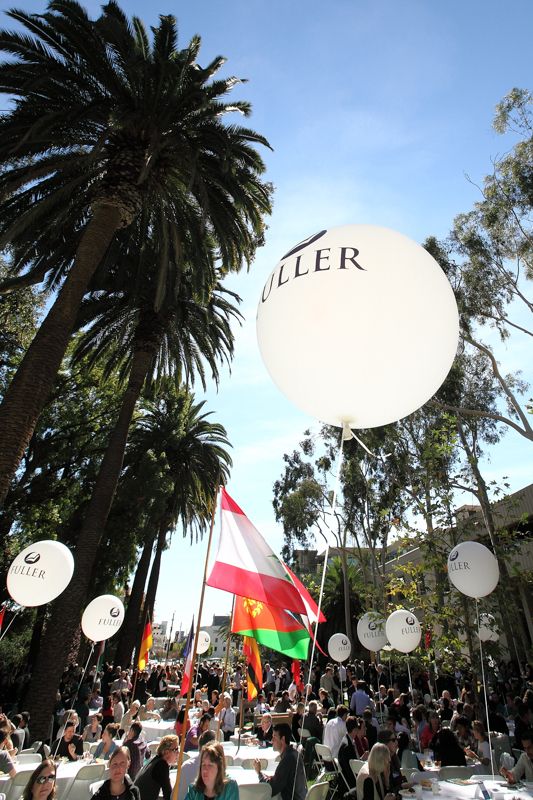 |
The November 2013 celebration of Mark Labberton's new leadership at Fuller Theological Seminary in Pasadena, California, included both traditional and innovative elements. Above, an outdoor lunch reception, featuring international food, live music, and student testimonies, was held on the seminary's Arol Burns Mall.
Credit: Fuller Theological Seminary |
“As much as you want to celebrate the history of the school, this is also an opportunity for the new president to cast a vision about what their leadership will mean,” says Victoria Smith at Fuller. So she recommends letting the new president have a substantial say in developing the program. Smith describes Fuller president Mark Labberton as a “world class orator, a Renaissance man, and an accomplished artist.” The inauguration committee wanted to make sure that the events celebrating his new leadership also reflected his passions and commitments.
Fuller incorporated an evening of worship and film into the schedule, and followed the service with an international-themed lunch reflecting Fuller’s global student body and the president’s interest in the church in exile.
Rick Barger’s inauguration service at Trinity Lutheran included Glen Hecox, a musical guest who is a longtime friend. It was music Barger loved sung by someone special in his life. The service itself was kept deliberately short, respecting Barger’s less-is-more approach. “I’ve gone to some inaugurations where there is speech after speech after speech,” says Barger. “And then the person being inaugurated gives a speech.” Barger decided to do things his own way. “I stood up and said: ‘I’m looking around this room; I assume that you are all in for supporting Trinity this day forward.’ That was it, and I sat down.”
At Knox, Samuel Lamerson’s speech lasted about four minutes longer than Barger’s. “I welcomed guests and thanked them for coming. After 45 minutes, they don’t want to hear anymore. It’s all been said.” Lamerson chose a hymn he loved, and a student led the congregation in worship.
Less can be more with budgets too
“I don’t think anyone left thinking, ‘Really cheap!’” says Luther’s Robin Steinke. “But you can do a lot of nice things on a budget.”
And of course, in an era of restrained budgets in general, an event that is too extravagant can send the wrong message. “Keeping the balance between wide-open imagination and realism about how much money you want to sink into this — that’s very important,” says Craig Koester. “Find creative ways to accomplish as much as you can on the priorities you have, with the resources you deem reasonable to spend on this venture. We tried to provide enough that it would be a fine event, but without being prodigal in our expenditure.”
At Knox, the belt was pulled tightly. “We didn’t have much money at the time,” says Samuel Lamerson. “We had volunteers help with the decorations. The only thing we really paid for was for the main speaker to come down. Other than that, we had cookies and punch after the inauguration, which didn’t cost much and was manned by volunteers. We wanted it to be nice and professional, and we want people to be proud of their school, but we don’t want to spend an exorbitant amount of money.”
Victoria Smith of Fuller offers an important reminder: “Class has no price range.” She says, “A lot can be accomplished with thoughtfulness and strategy and just taking care. Make sure the venue is clean and tidy. Set up the stage in a way that makes sense. Black and white gives a regal effect. Do things that make it look classic and pretty. Candles when appropriate create ceremony and ambiance without being overly expensive.”
The team at Knox tapped into the interior decorating expertise of the spouse of a board member. Her creative touch brought photographic enlargements of the Reformers that decorated the seminary library for an inauguration reception. Finger food was provided and Lamerson made sure he personally welcomed each guest. “That personal touch is much more important than anything you would spend money on,” he says. “I made sure I walked around and spoke to everyone individually and told them how happy I was they came.”
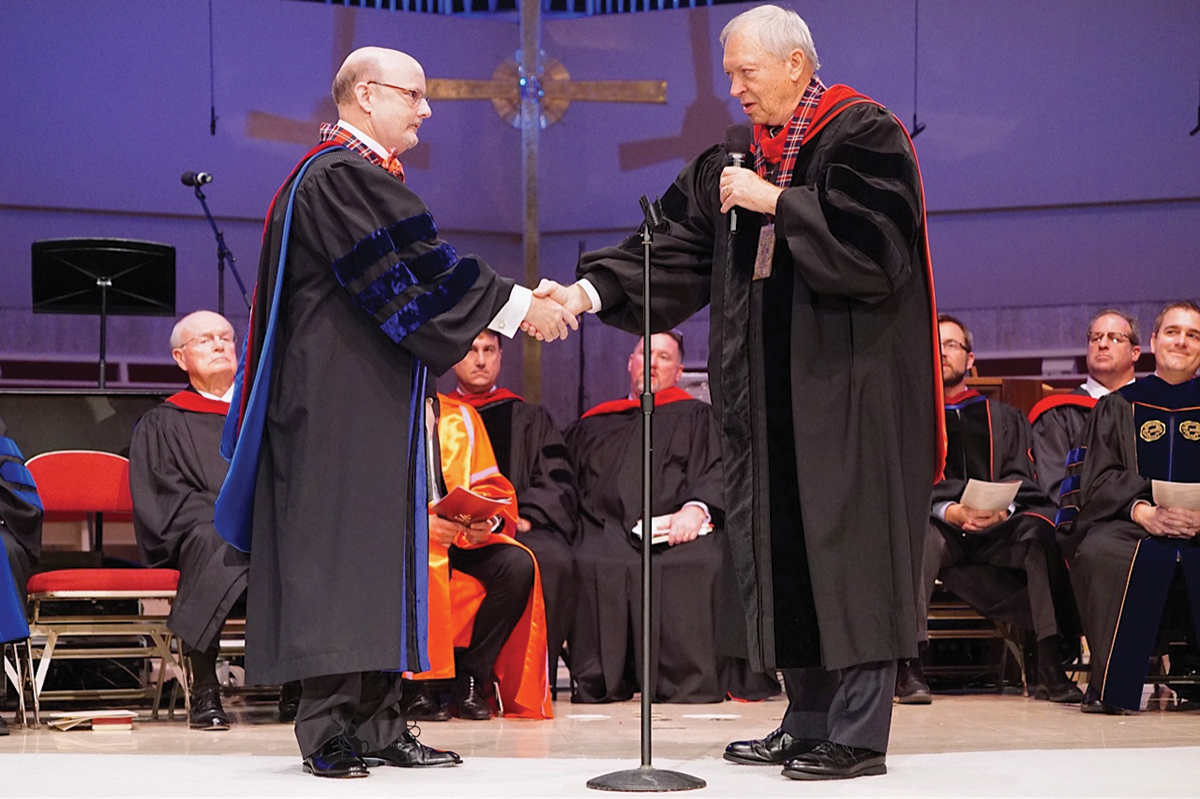 |
Two presidents: Knox Theological Seminary's president emeritus, Ron Kovack (right) welcomes his successor, Samuel Lamerson, during Lamerson's November 2014 inauguration.
Knox Theological Seminary |
Create a package of events
Beyond the service, this new milestone in the life of the school is a chance for other creative events to celebrate and acknowledge this new direction. When Father Mark Francis was inaugurated as president of Catholic Theological Union (CTU) in Chicago, the school seized on the opportunity to get in the public eye with a series of speaking events that lasted an entire semester. “The committee decided that instead of a one day event, they would have a ‘Season of Welcome,’” says Francis, who is a member of the Clerics of St. Viator, one of the religious orders that sponsor CTU. Laughing, he adds, “I was beginning to call it a ‘Gauntlet of Welcome.’”
At Fuller, the inauguration itself was followed by an educational symposium that Victoria Smith calls “an academic counterpoint” to the festivities. Other schools have put on similar events — leadership workshops or public lectures that showcase the new president and reinforce the message that a new day has dawned in the life of the school.
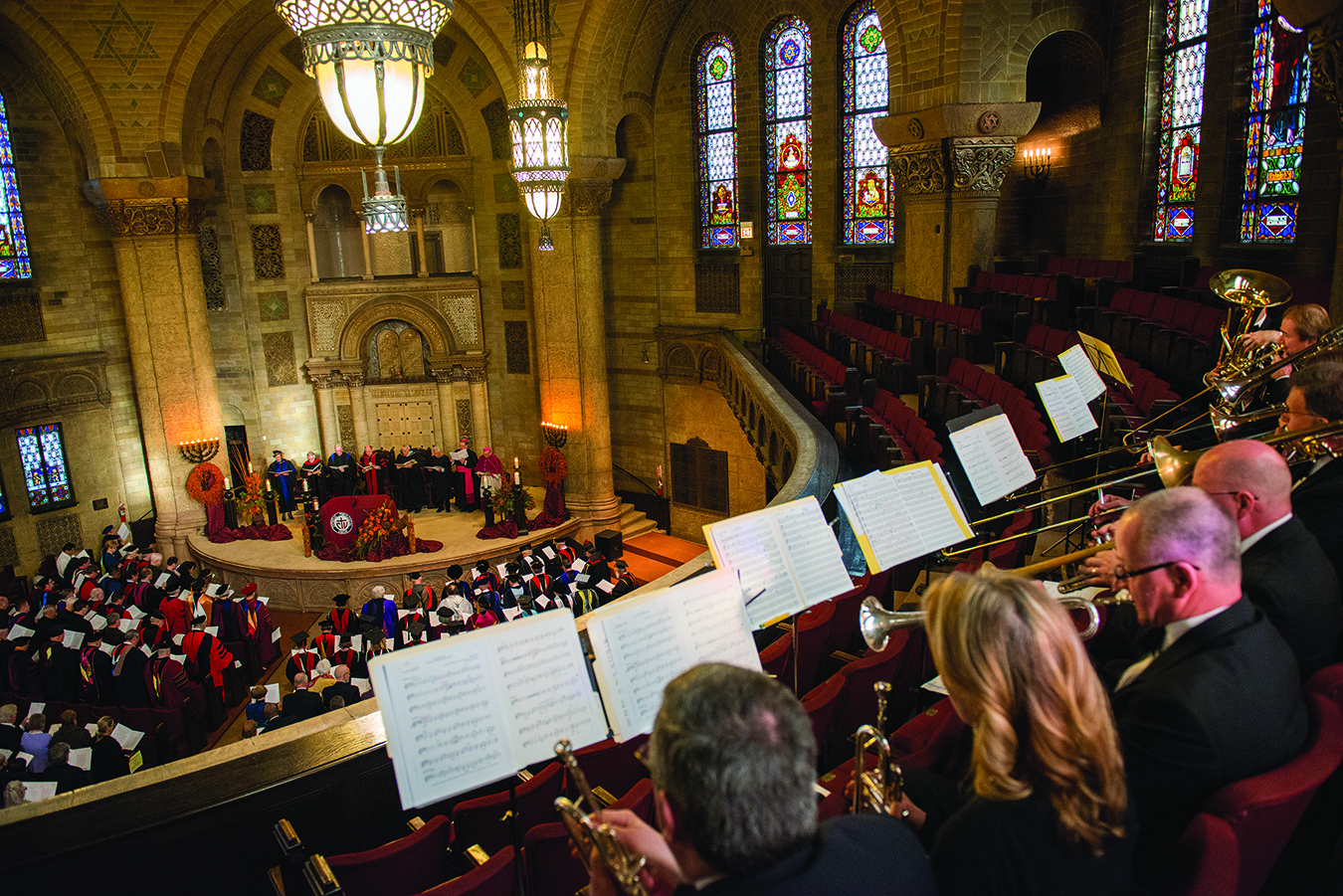 |
The October 2013 inauguration of Father Mark R. Francis as president of Catholic Theological Union was held at KAM Isaiah Israel synagogue in Chicago, and included music by the Millar Brass Ensemble.
Credit: Catholic Theological Union |
The role of board members
Tapping into volunteer expertise is just one small way to include the board in inaugural events. Board members should certainly be part of the carefully planned processional walk as well, and Victoria Smith advises a rehearsal for the march. Set up guides along the route for the real thing, she advises. She’s seen some processions go very wrong!
The board should be acknowledged at the inaugural service itself and should almost certainly play a role. Robin Steinke asked the board to stand during the inauguration and invited the community’s prayer for their ongoing stewardship of Luther. At Fuller, the chair of the board gave the inauguration charge to the new president. Another common event: A celebratory dinner for board members, spouses, and the new president to mark this new beginning in the life of the institution.
In the end, enjoy it
“My biggest piece of advice is to enjoy it,” says Mark Francis, the new president at Catholic Theological Union. “It’s a wonderful moment to celebrate the school. That’s the issue. It’s not so much about the president, but about the great things the school is doing.”
And in the end, that’s what Rick Barger, the reluctant inauguree, had no difficulty doing. He was the last to leave the the reception that followed the service. In a show of Cana-like hospitality, he brought out more wine even after the bartenders had left the building. “It was a celebratory event and it truly marked a new day,” says Barger. “I realized just how important this was—and is — to any institution that has called new leadership. It is a pivotal, liminal moment in the life of the seminary.”
Ultimately, to Barger’s relief, it wasn’t really much about him. “It was more about Trinity, and the God who raises the dead, and God’s mission in the world.”
Quick tips for the event planner
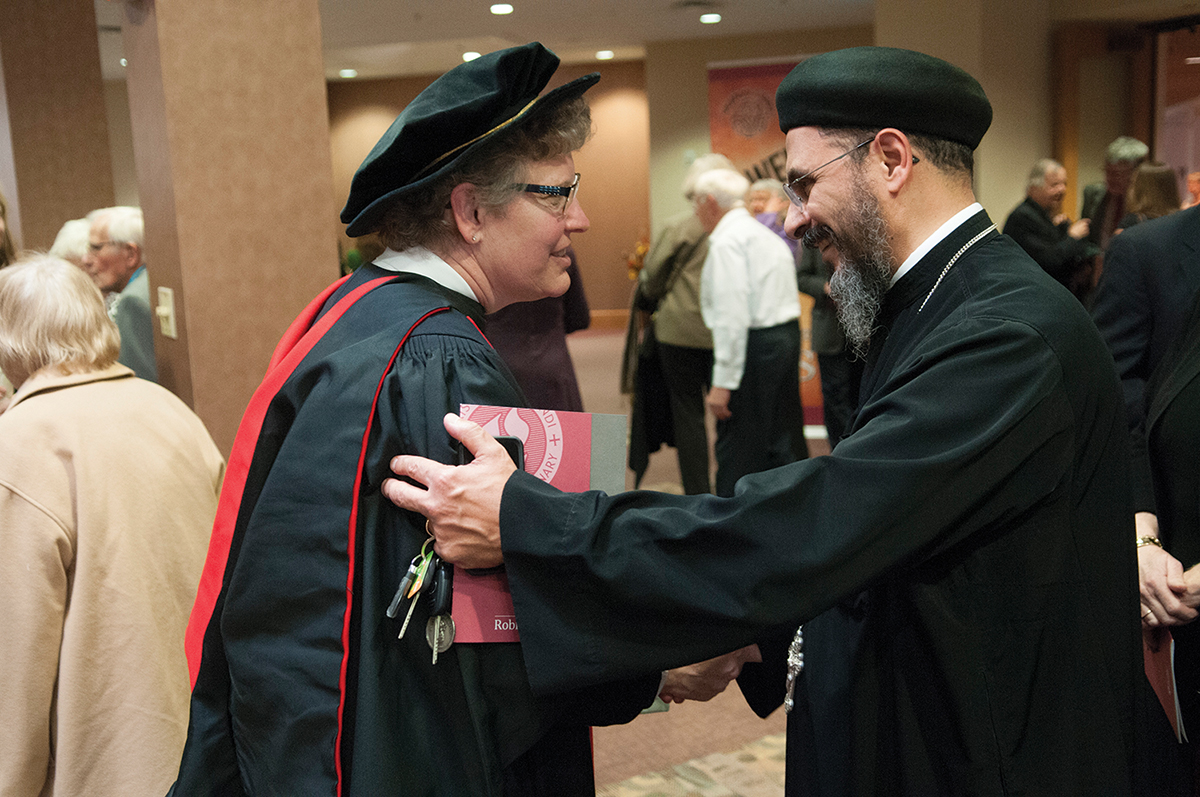 |
Father Youannes Fahim Tawfik of St. Mary Coptic Orthodox Church in St. Paul, Minnesota, greeted Luther Seminary's new president, Robin J. Steinke, at her October 2014 inauguration.
Credit: Luther Seminary |
Not every institution has a full-time, experienced event planner on staff. Victoria Smith, who fills that role at Fuller, offers some useful advice.
- Staff up. Have more volunteers than you think you need. Break them into teams, and have training meetings for each volunteer squad. Enlist students and younger graduates!
- Assemble an entourage. Assign one escort to the president and one to the president’s spouse and ask them to stay by their sides throughout the day. “Make sure you have someone they feel comfortable with — someone who can give them space and distance, but someone who can also be the bad guy and say, ‘The service starts in 10 minutes.’”
- Be heard. Order more headsets and microphones than you think you will need.
- Pay attention to detail. Place water bottles and programs on the seats of faculty, board members, and special guests. “The message you want to send is: ‘We’ve thought this through. We care about you.’”
- Script everything. Rehearse everything, including the movements on the stage. “You don’t want people bumping into one another.”
- Use a multimedia approach. Fuller created a special publication that included the inaugural addresses of past presidents, along with Mark Labberton’s talk. The publication was distributed as people left the event and was mailed to alumni around the world. Live streaming is common and expected. Use social media to build anticipation and follow up with those who can’t attend.